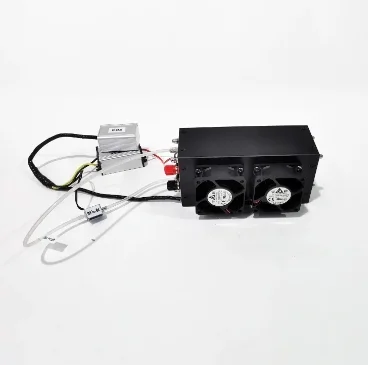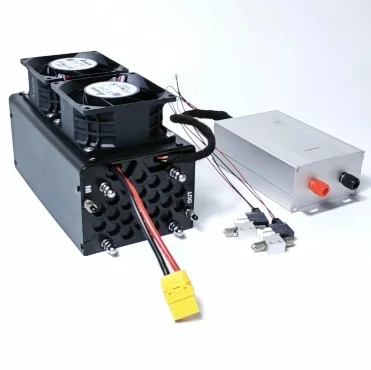Step into the world of hydrogen fuel cell stacks, where advanced technology intersects with sustainable energy solutions! In today's post, we will explore the intriguing world of industrial uses for these powerful stacks. If you're intrigued by their functionality and impact on different sectors, you've landed in the perfect spot. Buckle up and join us on an exhilarating journey through the potential of hydrogen fuel cell stacks!
How Do Hydrogen Fuel Cell Stacks Work?
Hydrogen fuel cell stacks are at the forefront of clean and efficient energy technologies. But how exactly do they work? Let's delve into the fascinating inner workings of these powerhouses.
At its core, a hydrogen fuel cell stack is made up of individual cells that convert chemical energy from hydrogen and oxygen into electrical energy through an electrochemical process. Each cell consists of two electrodes - an anode and a cathode - separated by an electrolyte.
The process begins as hydrogen gas is supplied to the anode side of the fuel cell stack, where it undergoes oxidation, releasing electrons in the process. These electrons then travel through an external circuit, creating usable electric current.
Simultaneously, on the cathode side, oxygen gas from the surrounding air combines with electrons and protons (hydrogen ions) that have passed through the electrolyte. This reaction produces water vapor as a byproduct.
The key component that allows this reaction to occur efficiently is the catalyst layer located at each electrode. Typically made from platinum or other precious metals, these catalysts facilitate electron transfer between reactants without being consumed themselves.
By combining multiple individual cells together in series or parallel configurations within a stack, higher voltages can be achieved to meet specific power requirements for different applications - whether it's powering vehicles or providing backup electricity for industrial operations.
Hydrogen fuel cell stacks offer a promising solution for clean energy needs due to their high efficiency and zero-emission capabilities. With ongoing advancements in technology and infrastructure development, we can look forward to wider adoption of this sustainable energy source in various sectors such as transportation, telecommunications towers, grid balancing systems,and more!
Advantages of Using Hydrogen Fuel Cell Stacks in Industrial Applications
Hydrogen fuel cell stacks offer numerous advantages that make them highly suitable for various industrial applications. One key advantage is their high efficiency in converting hydrogen into electricity, making them more energy-efficient than traditional combustion engines. This not only reduces carbon emissions but also minimizes reliance on fossil fuels, contributing to a cleaner and greener environment.
Another advantage is the versatility of hydrogen fuel cell stacks. They can be used in a wide range of industrial applications, including powering vehicles, providing backup power for critical systems, and even generating electricity for remote or off-grid locations. This flexibility makes them an attractive option for industries looking to diversify their energy sources and reduce dependence on conventional power grids.
Moreover, hydrogen fuel cells have a longer lifespan compared to batteries or other power storage technologies. This means reduced maintenance costs and increased reliability for industrial operations. Additionally, the refueling process is quick and easy with hydrogen fuel cells, allowing continuous operation without significant downtime.
Furthermore,One notable advantage of using hydrogen fuel cell stacks is their minimal environmental impact. Unlike internal combustion engines that produce harmful emissions such as carbon dioxide and nitrogen oxides during operation, hydrogen fuel cells only emit water vapor as a byproduct. This ensures cleaner air quality both indoors and outdoors while reducing greenhouse gas emissions.
Additionally,Hydrogen is abundantly available across the globe through various renewable sources such as wind turbines or solar panels. By harnessing this sustainable resource with fuel cell technology, industries can reduce their reliance on limited fossil fuels while promoting a more sustainable energy future.
Lastly,The compact size and lightweight nature of hydrogen fuel cell stacks make them ideal for integration into diverse industrial equipment or vehicles without compromising performance or efficiency. Their silent operation also provides an added advantage in noise-sensitive environments where minimizing sound pollution is crucial.
In summary,The advantages offered by hydrogen fuel cell stacks are undeniable when it comes to industrial applications. From increased energy efficiency and environmental benefits to versatility and reliability, these fuel cells.

Industrial Applications of Hydrogen Fuel Cell Stacks
Industrial applications of hydrogen fuel cell stacks have gained significant attention in recent years due to their numerous advantages and potential for sustainable energy solutions. These advanced technologies offer a wide range of uses across various industries, revolutionizing the way we power our world.
One prominent application is in the transportation sector, where hydrogen fuel cell stacks are being utilized to power vehicles. This includes cars, trucks, buses, and even trains. By converting chemical energy from hydrogen into electricity through a chemical reaction with oxygen in the air, these fuel cells provide an efficient and clean alternative to traditional combustion engines.
In addition to transportation, hydrogen fuel cell stacks also find applications in stationary power generation. They can be used as backup or primary power sources for industrial facilities such as data centers, manufacturing plants, and remote off-grid locations. The ability to produce electricity on-site using hydrogen allows for greater independence from traditional grid systems while reducing carbon emissions.
Hydrogen fuel cell stacks are also making strides in the renewable energy sector by enabling storage and utilization of excess energy generated from renewable sources like solar and wind. By storing this surplus energy as hydrogen gas via electrolysis during times of low demand or high production capacity, it can be later converted back into electricity when needed using fuel cells.
Another notable application is within the telecommunications industry where reliable backup power systems are crucial for uninterrupted communication services. Hydrogen fuel cells offer longer runtimes compared to conventional batteries without compromising performance or reliability.
The use of hydrogen fuel cell stacks extends beyond just providing clean and efficient energy solutions; they also play a pivotal role in creating sustainable alternatives for chemical processes such as refining petroleum products or producing ammonia for fertilizer production. With zero-emission operation and high efficiency levels compared to conventional methods, these advancements contribute significantly towards reducing greenhouse gas emissions associated with industrial activities.
While there are still challenges that need addressing before widespread adoption becomes a reality - such as cost reduction strategies and infrastructure development - it's undeniable that hydrogen fuel cell stacks have immense potential for revolutionizing industrial applications. With ongoing research and development
Industrial Hydrogen Fuel Cell Stacks: Challenges and Auture
As with any emerging technology, hydrogen fuel cell stacks face their fair share of challenges when it comes to widespread adoption in industrial applications. One of the main hurdles is the high cost associated with producing and implementing these systems. The infrastructure required to support hydrogen fuel cell technology is still limited, making it difficult for industries to fully integrate this clean energy solution into their operations.
Another challenge lies in the storage and transportation of hydrogen gas. While advancements have been made in developing efficient storage methods, there is still work to be done to ensure safe and reliable distribution across various industries.
Furthermore, durability and lifespan are important considerations when it comes to fuel cell stacks. Industrial applications often require continuous operation under demanding conditions, which can put strain on the longevity of these systems. Ongoing research focuses on improving the durability and reliability of fuel cells to meet industry standards.
Despite these challenges, there are promising future possibilities for using hydrogen fuel cell stacks in industry. As renewable energy sources gain traction globally, there is an increasing need for sustainable power solutions that can reduce greenhouse gas emissions. Hydrogen fuel cells offer a viable option as they produce electricity without harmful byproducts.
Moreover, advancements in materials science and engineering continue to enhance the performance of fuel cells while reducing costs associated with production and implementation. Research efforts aim at developing more efficient catalysts, membranes, and other components that will improve overall efficiency while lowering operational expenses.
In addition to stationary power generation applications such as backup power for critical infrastructure or microgrids, hydrogen fuel cell stacks show potential for use in transportation sectors like heavy-duty trucks or even maritime vessels where electrification may not be feasible due to weight restrictions or long-distance travel requirements.
The journey towards wider industrial adoption of hydrogen fuel cell stacks may have its obstacles but holds immense potential for a cleaner future powered by sustainable energy alternatives.

Conclusion
Hydrogen fuel cell stacks have emerged as a promising technology for various industrial applications. These efficient and clean energy systems offer numerous advantages, making them an attractive option for industries looking to reduce their carbon footprint and increase energy efficiency.
In this article, we explored how hydrogen fuel cell stacks work by converting hydrogen into electricity through an electrochemical process. By combining hydrogen with oxygen from the air, these stacks produce electricity without any harmful emissions, only releasing water vapor as a byproduct.
The advantages of using hydrogen fuel cell stacks in industrial applications are significant. They provide high efficiency, reliability, and durability compared to other power generation technologies. Moreover, they can be easily integrated into existing infrastructure and operate silently while requiring minimal maintenance.
When it comes to industrial applications, hydrogen fuel cell stacks have vast potential. They can power material handling equipment such as forklifts in warehouses or serve as backup power sources in data centers and telecommunication facilities. Additionally, they hold promise in providing clean energy for transportation sectors such as buses or even powering entire buildings.
Looking ahead to the future possibilities of using hydrogen fuel cell stacks in industry gives us reason to remain optimistic. As advancements continue to enhance stack performance and lower costs associated with production and distribution infrastructure improve over time; we may see more widespread implementation across various sectors.
In conclusion, it is evident that the application of hydrogen fuel cell stacks holds immense potential for revolutionizing our industrial landscape by providing cleaner and more sustainable solutions for meeting our energy needs.